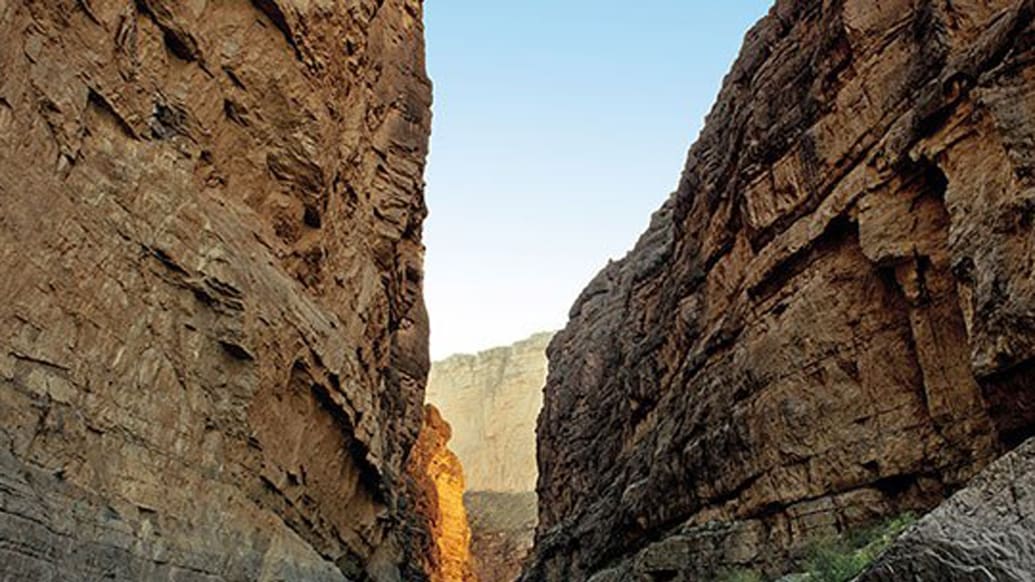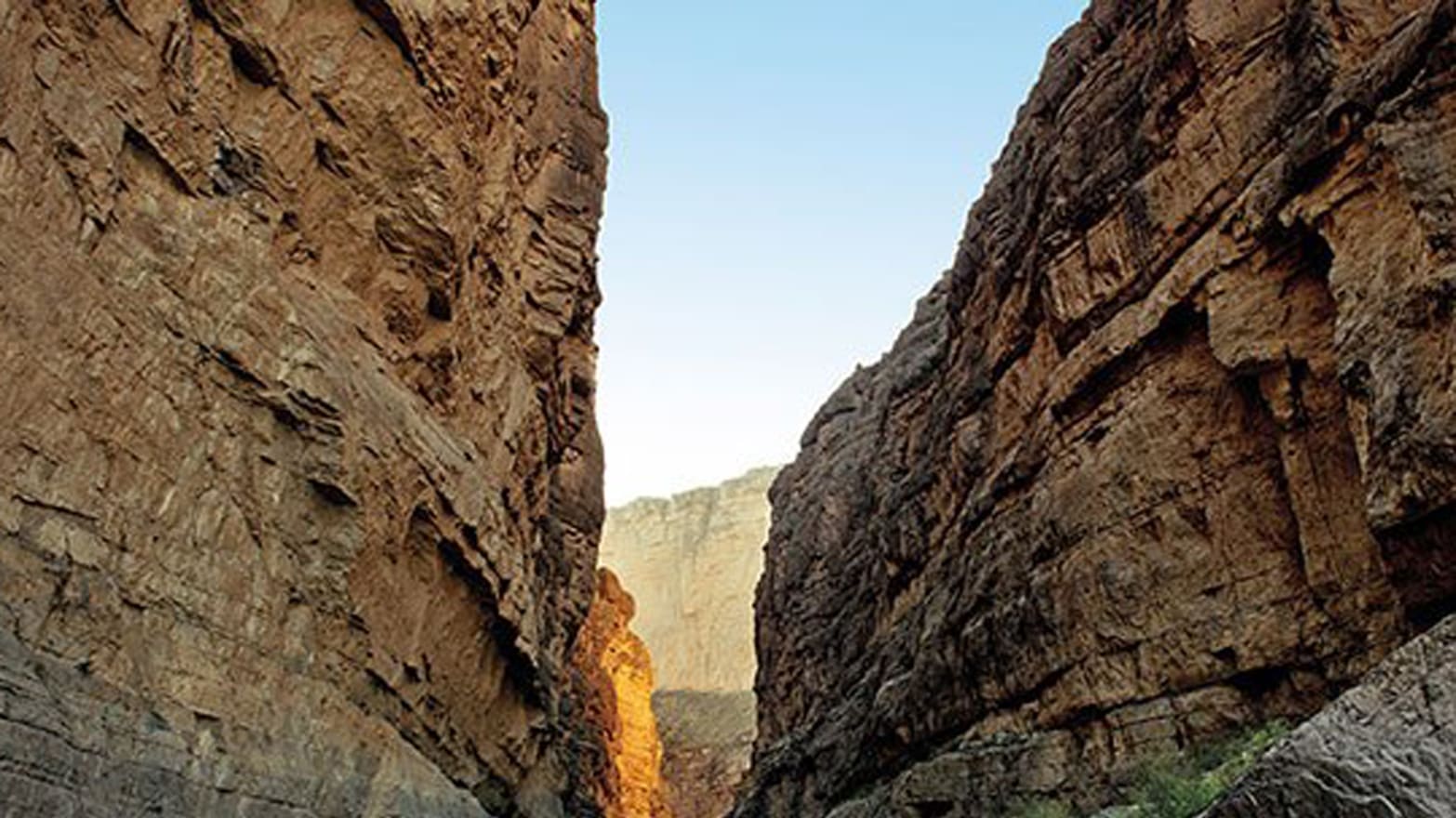by Stephen Orr
“Señor!” I heard from across the river. A group of friends and I had just settled into a small pool at Boquillas Hot Springs, which sits perched alongside the rushing Rio Grande. We were in the middle of our annual West Texas road trip and entirely alone except for a burro and its owner, the smiling, waving man on the other side of the rapids. He lobbed an object that made a soft landing in a mound of grass a few yards away from us. It was a fist-size amethyst, glistening violet in the sun. "How much?" I asked. "One dollar," he said and threw a plainer stone with a rubber band looped around it for our payment. We told him we wanted to buy more, so our new friend waded across the river to show us his full inventory, all the while remaining in the water. "Mexico," he said pointing at his feet. "U.S.," he said next, pointing to where we stood, shaking his head to indicate that he wouldn't step ashore. We left the springs with a bagful of colorful rocks and one more story to tell.

This part of the country, somewhat isolated in an elbow (or big bend, which gives Big Bend National Park its name) of the Rio Grande and just north of the international border, is a land of few roads, few people, big skies, and chance encounters. Growing up about five hours northeast of here, in the medium-size town of Abilene, I never appreciated the wonder of the wide-open spaces around me. But now that I've lived in New York so long, I do. And so every October, when the days are mild and the nights crisp, I make a pilgrimage to West Texas with a group of 40 or so college friends from the University of Texas. From El Paso Airport, we head out on I-10, spending the next four or five days making a wide loop through the region's spectacular—and spectacularly varied—landscapes. We change the itinerary every year, but along the way we enjoy rugged hikes, spicy barbecue and Mexican food, and some of the most remote little towns you're ever likely to encounter.
Scene 1: El Paso to Balmorhea
The huge I-10, thick with truck traffic, climbs up more than 1,000 feet in elevation out of the flat, dusty desert that surrounds El Paso. Mountain passes lead to high plains dotted with green scrub and otherworldly rock outcroppings. Along the way are wide, empty expanses, a few small roadside communities, and a Department of Homeland Security checkpoint in Sierra Blanca, where the canine patrols routinely sniff out drug-toting celebrities—Willie Nelson, Fiona Apple, Snoop Lion (né Dogg), and Nelly, among others—as they head to gigs on their tour buses.
Once you leave the interstate at the easy-to-miss exit for Balmorhea State Park, any reminders of TMZ's crime reports are replaced by pure silence. This rural crossroads of a town (population: 435) is best known for its vast artesian San Solomon Springs. Apaches used what was once a marshy ciénaga as a water hole for centuries. During the Depression, the Civilian Conservation Corps dammed the springs to form a 77,000-square-foot swimming hole and built a recently renovated 18-room adobe motor court. The cool, crystal-clear waters flow at a rate of up to 28 million gallons per day into the natural-bottom pool, its rocky nooks and crannies inhabited by crayfish, catfish, and rare native pupfish and gambusia. In spring and fall, the pool is often blissfully empty, the serenity disturbed only by the occasional scuba diver or cannonball jump from the high dive.
Highway 17 leads out of Balmorhea straight as a shot aimed at the fortress-like Davis Mountains. The scenic road winds along Limpia Creek, with its rustling cottonwoods and dramatically eroded stone formations resembling crowds of carved totems. It then climbs over Wild Rose Pass, where you'll spot silk roses tied to the roadside border of shrubs (the work of some local romantic), and heads down to Fort Davis. This tiny, tidy town is home to the quaintly historic Hotel Limpia, a surprising number of shops (including one that specializes in handmade brooms), the organic Stone Village Market, and a few restaurants near the 1854 fort. The mile-long stretch of road leading out of Fort Davis is one of my favorite drives, as it cuts through open plains of blond grasses and past the occasional group of pronghorn antelope. Blue mesas poke above the distant horizon line, and a domed courthouse grows larger as you near Marfa.
Scene 2: Marfa
These days when I say I'm going to West Texas, people ask, "To Marfa?" almost without fail. But for me, Marfa is really the gateway to all that this unspoiled region has to offer. This town of just a couple thousand people has gained a worldwide reputation as an art hub and has introduced a new kind of culture in the area. Once a ranching community and railroad stop, Marfa came into the national consciousness as the filming location for the 1956 movie Giant. Elizabeth Taylor, James Dean, and Rock Hudson all stayed at El Paisano, still the grandest hotel in town. Today, Marfa is most famous for the work of minimalist sculptor Donald Judd (1928–94), who moved here in 1971 and began creating artwork of metal, concrete, or wood that pays homage to the stark geometry of the flat plains around him. Over the years, the town has attracted other artists, gallerists, and rugged individualists who want to distance themselves either full- or part-time from the frenzy of modern daily life. One of the most influential, Austin-based hotelier Liz Lambert, has created two distinctive properties: the mid-century Thunderbird Hotel, as well as El Cosmico, a neo-bohemian collection of Airstreams, tepees, and yurts. Lambert's Trans-Pecos Festival of Music & Love is held every September, drawing alt-rock music lovers from across the country to gather round fires, drink beer, and sample a modern take on camp cooking—all under some of the darkest, starriest skies in the continental United States.
Scene 3: Alpine
Half an hour due east of Marfa is the tiny college town of Alpine. On a quiet side street there, Alicia's Burrito Place features both the meat-and-potatoes cowboy cooking I remember from my West Texas childhood along with spicier influences from New Mexico. The hamburger is pure Texas, pounded thin without a hint of pink in its center and served on a toasted, buttered bun, but the pork chili verde, a dish you won't find much farther east than here, is shockingly hot, with a rich green chili gravy. One of my favorite Western stores, Big Bend Saddlery, is here too, just a quick drive up the highway. The rawhide smell hits you like a wall as you enter the door to find rows of beautifully crafted leather saddles and hand-tooled belts, as well as intricate metal cowboy belt buckles and hand-creased Western hats made from classic beaver felt—everything a self-respecting cowboy could ever need.
Scene 4: Marathon
If you want to linger for a couple of days on your way to Big Bend National Park, the sleepy town of Marathon is home to the Gage Hotel, which was built by a ranch owner in the 1920s. Even at two stories, the brick edifice seems to tower over the rest of the town. Rooms in the historic building are smaller, while the larger, more luxurious Los Portales posadas overlook garden courtyards. Down the street, Shirley's Burnt Biscuit serves breakfast with very good (not burnt) biscuits and fried pies. And a few minutes' walk away is Eve's Garden Organic B&B, where artist Kate Thayer and her son and daughter-in-law have created an unexpected work of folk art that remains in constant development. The vividly painted walls, cornices, staircases, and whimsical sculptures are entirely constructed with papercrete, a highly sculptural building material made of recycled paper pulp and Portland cement. The Houston-born Thayer is a prime example of the many West Texan transplants who leave the city to follow their dreams here, no matter how eccentric and improbable.
Scene 5: Big Bend National Park
As you leave Marathon, traveling through sprawling ranchlands and the northeastern section of the Chihuahuan Desert, the sky seems even bigger, the landscape even grander. And so it is. Big Bend National Park is larger than the state of Rhode Island, and a visitor could easily spend a week here, hiking and driving through its rugged mountain scenery. We usually opt for a few days, basing ourselves at the Chisos Mountains Lodge, the only place to stay in the entire park. Situated at 5,400 feet, it's encircled by jagged peaks that make you feel you're cupped inside a caldera. Start with the Lost Mine Trail, which begins at the lodge and is a half-day hike that leads to epic views over the backside of the park. Another day, head down to the border to explore Santa Elena Canyon, which sits on the Rio Grande. And in the late afternoon, be sure to take a short hike to see the sun begin to set in the gorge.
Then there's Terlingua, about an hour's drive west of Chisos. An 1880s mercury-mining town reclaimed in the 1960s by artists and hippies, it's home to the area's only nightspots: the Starlight Theatre Restaurant & Saloon, which serves excellent steaks and hosts local musicians, and the subterranean La Kiva Restaurant and Bar, which has an inimitable cowboy-goth decor.
Scene 6: The Return
Here you have a choice: You can either drive back to El Paso the same way you came or take I-70 to Lajitas until it becomes River Road. This 50-mile stretch provides a rough, borderlands kind of beauty as the road climbs and dives along the Rio Grande. Head north at the hardscrabble town of Presidio, which is home to two art-world notables: the realist painter Rackstraw Downes, and Simone Swan, the former director of Houston's Menil Foundation, who runs the Adobe Alliance, which teaches traditional building techniques.
And then it's time to go—back to the El Paso Airport, maybe. Or to spend a last night or two at the luxurious Cibolo Creek Ranch resort (located on 30,000 acres, complete with its own landing strip). While you're passing through Marfa, stop at the decidedly un-Texan Food Shark truck, which has fattoush and vegetarian options—likely a welcome change after all the barbecue and Tex-Mex you've enjoyed. And then, too soon, you're on your way back to city life…until next year, that is.
More From Condé Nast Traveler:
- This is the Most Photogenic Place on Earth
- America's Best Sandwiches
- The Trick to the Perfect Winter Cross-Country Road Trip
- Stunningly Beautiful Alpine Lakes
- The World’s Longest Flights
